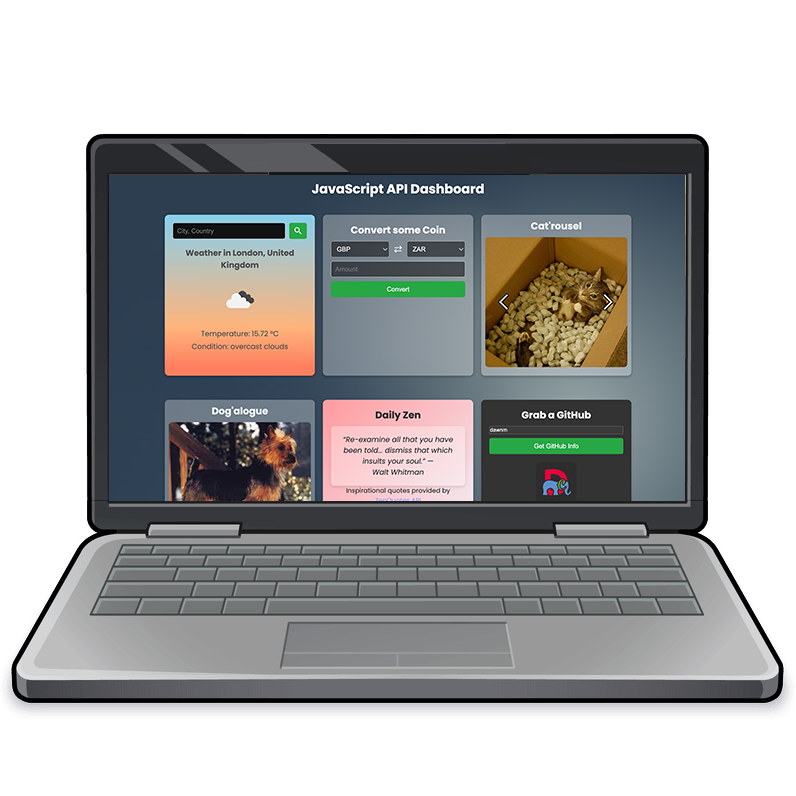API Expedition
Building a Dashboard with Multiple Sources and Copilot Guidance
Introduction
For this project, we were set the task of building a dashboard that pulled data from several different APIs. The aim was twofold: to really get to grips with working with multiple external data sources and to see how GitHub Copilot could assist in the process. It also presented a perfect opportunity to dive into CSS Grid for the layout and its responsive capabilities, for which I found a particularly helpful resource at CSS Grid Garden. I'm particularly chuffed with how this turned out, especially considering my past struggles with JavaScript!
Taming Multiple APIs with Copilot by My Side
The core of this dashboard lies in its ability to fetch and display information from various APIs. It was fascinating to see how different APIs structure their data and the nuances involved in making requests and handling responses. This is where GitHub Copilot proved to be an invaluable assistant.
Having Copilot suggest code snippets for API calls, data parsing, and even error handling was a real game-changer. It wasn't about blindly accepting suggestions, mind you. It was more like having an experienced pair programmer offering ideas and shortcuts. It helped me to:
- Explore API Endpoints: Copilot often suggested relevant endpoints based on the API documentation I had open.
- Structure Fetch Requests: It provided sensible structures for
fetchrequests, saving me time on syntax and boilerplate. - Handle JSON Responses: Copilot assisted in navigating the nested structures of JSON data, making it easier to extract the specific information I needed.
- Implement Basic Error Handling: It prompted me to consider
try...catchblocks and how to display informative error messages.
While I still had to understand the logic and adapt the code to my specific needs, Copilot significantly sped up the development process and helped me push through areas where I might have previously gotten stuck. It felt like a collaborative effort, even though I was the one at the keyboard.
CSS Grid:
A Layout Adventure, Responsively Sorted (with thanks to CSS Grid Garden)
For the visual structure of the dashboard, I decided to take CSS Grid for a spin. To really get to grips with the concepts, I worked through the excellent exercises at CSS Grid Garden, which provided a fantastic interactive way to learn the fundamentals. This project then gave me a proper chance to explore its power and flexibility, especially when it came to making the layout responsive.
I found CSS Grid to be incredibly intuitive for arranging the different sections of the dashboard. Defining grid areas and placing elements within them felt much more natural than previous layout methods for this kind of multi-panel interface. The knowledge I gained from CSS Grid Garden was instrumental in understanding how to structure the grid effectively.
The real 'aha!' moment came when tackling responsiveness. By using media queries and redefining the grid template areas and column/row definitions, I could easily rearrange the dashboard for smaller screens. Elements that were side-by-side on a desktop neatly stacked on mobile, providing a much better user experience. It was a satisfying exercise in seeing how a well-defined grid, built upon the principles learned from CSS Grid Garden, could adapt so gracefully.
Pushing Past the JavaScript Gremlins
Looking back, my previous encounters with JavaScript often left me feeling thoroughly frustrated. This project, however, felt different. Perhaps it was the benefit of having a live tutor to guide me, or the assistance of Copilot, but I found myself able to work through the JavaScript logic with much more confidence.
Fetching data from multiple APIs, updating the DOM with the retrieved information, and handling the asynchronous nature of these operations were all challenges I managed to overcome. There were still moments of head-scratching, of course, but the feeling of finally getting the data to display correctly was incredibly rewarding. It's given me a real boost in confidence and a renewed enthusiasm for JavaScript.
Final Thoughts
This API dashboard project was a significant step forward for me. It showcased my ability to work with diverse data sources, effectively utilise AI-assisted development tools, and implement modern CSS layout techniques for responsiveness, all while building upon the CSS Grid foundations I solidified thanks to CSS Grid Garden. Most importantly, it represents a personal victory in overcoming my previous JavaScript anxieties. I'm genuinely pleased with the outcome and feel it’s a strong addition to my portfolio, demonstrating my willingness to tackle new challenges and embrace modern web development practices.

